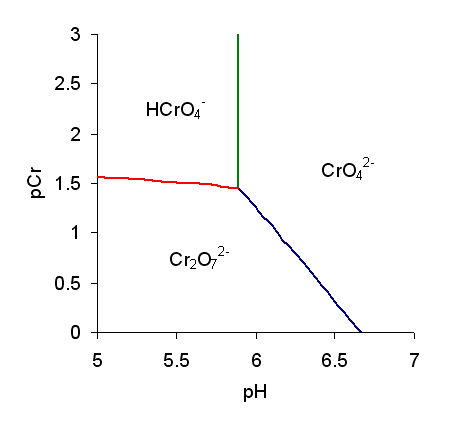|
Dichromic Acid
The term chromic acid is usually used for a mixture made by adding concentrated sulfuric acid to a dichromate, which may contain a variety of compounds, including solid chromium trioxide. This kind of chromic acid may be used as a cleaning mixture for glass. Chromic acid may also refer to the molecular species, H2CrO4 of which the trioxide is the anhydride. Chromic acid features chromium in an oxidation state of +6 (or VI). It is a strong and corrosive oxidising agent. Molecular chromic acid Molecular chromic acid, H2CrO4, has much in common with sulfuric acid, H2SO4. Only sulfuric acid can be classified as part of the 7 strong acids list. Due to the laws pertinent to the concept of "first order ionization energy", the first proton is lost most easily. It behaves extremely similar to sulfuric acid deprotonation. Since the process of polyvalent acid-base titrations have more than one proton (especially when the acid is starting substance and the base is the titrant), proton ... [...More Info...] [...Related Items...] OR: [Wikipedia] [Google] [Baidu] |
Chromate And Dichromate
Chromate salts contain the chromate anion, . Dichromate salts contain the dichromate anion, . They are oxyanions of chromium in the +6 oxidation state and are moderately strong oxidizing agents. In an aqueous solution, chromate and dichromate ions can be interconvertible. Chemical properties Potassium-chromate-sample.jpg, potassium chromate Potassium-dichromate-sample.jpg, potassium dichromate Chromates react with hydrogen peroxide, giving products in which peroxide, , replaces one or more oxygen atoms. In acid solution the unstable blue peroxo complex Chromium(VI) oxide peroxide, CrO(O2)2, is formed; it is an uncharged covalent molecule, which may be extracted into ether. Addition of pyridine results in the formation of the more stable complex CrO(O2)2py. Acid–base properties In aqueous solution, chromate and dichromate anions exist in a chemical equilibrium. :2 + 2 H+ + H2O The predominance diagram shows that the position of the equilibrium depends on b ... [...More Info...] [...Related Items...] OR: [Wikipedia] [Google] [Baidu] |
Pyridine
Pyridine is a basic heterocyclic organic compound with the chemical formula . It is structurally related to benzene, with one methine group replaced by a nitrogen atom. It is a highly flammable, weakly alkaline, water-miscible liquid with a distinctive, unpleasant fish-like smell. Pyridine is colorless, but older or impure samples can appear yellow, due to the formation of extended, unsaturated polymeric chains, which show significant electrical conductivity. The pyridine ring occurs in many important compounds, including agrochemicals, pharmaceuticals, and vitamins. Historically, pyridine was produced from coal tar. As of 2016, it is synthesized on the scale of about 20,000 tons per year worldwide. Properties Physical properties The molecular electric dipole moment is 2.2 debyes. Pyridine is diamagnetic and has a diamagnetic susceptibility of −48.7 × 10−6 cm3·mol−1. The standard enthalpy of formation is 100.2 kJ·mol−1 in the liquid phase ... [...More Info...] [...Related Items...] OR: [Wikipedia] [Google] [Baidu] |
Hair Dye
Hair coloring, or hair dyeing, is the practice of changing the hair color. The main reasons for this are cosmetic: to cover gray or white hair, to change to a color regarded as more fashionable or desirable, or to restore the original hair color after it has been discolored by hairdressing processes or sun bleaching. Hair coloring can be done professionally by a hairdresser or independently at home. Today, hair coloring is very popular, with 75% of women and 18% of men living in Copenhagen having reported using hair dye (according to a study by the University of Copenhagen). At-home coloring in the United States reached $1.9 billion in 2011 and was expected to rise to $2.2 billion by 2016. History Diodorus Siculus, a Greek historian, described in detail how Celtic people dyed their hair blonde: "Their aspect is terrifying... They are very tall in stature, with rippling muscles under clear white skin. Their hair is blond, but not naturally so: they bleach it, to this day, artifi ... [...More Info...] [...Related Items...] OR: [Wikipedia] [Google] [Baidu] |
Patina
Patina ( or ) is a thin layer that variously forms on the surface of copper, brass, bronze and similar metals and metal alloys (tarnish produced by oxidation or other chemical processes) or certain stones and wooden furniture (sheen produced by age, wear, and polishing), or any similar acquired change of a surface through age and exposure. Additionally, the term is used to describe the aging of high-quality leather. The patinas on leather goods are unique to the type of leather, frequency of use, and exposure. Patinas can provide a protective covering to materials that would otherwise be damaged by corrosion or weathering. They may also be aesthetically appealing. Usage On metal, patina is a coating of various chemical compounds such as oxides, carbonates, sulfides, or sulfates formed on the surface during exposure to atmospheric elements (oxygen, rain, acid rain, carbon dioxide, sulfur-bearing compounds). In common parlance, weathering rust on steel is often mistakenly refe ... [...More Info...] [...Related Items...] OR: [Wikipedia] [Google] [Baidu] |
Brass
Brass is an alloy of copper (Cu) and zinc (Zn), in proportions which can be varied to achieve different mechanical, electrical, and chemical properties. It is a substitutional alloy: atoms of the two constituents may replace each other within the same crystal structure. Brass is similar to bronze, another copper alloy, that uses tin instead of zinc. Both bronze and brass may include small proportions of a range of other elements including arsenic (As), lead (Pb), phosphorus (P), aluminium (Al), manganese (Mn), and silicon (Si). Historically, the distinction between the two alloys has been less consistent and clear, and modern practice in museums and archaeology increasingly avoids both terms for historical objects in favor of the more general "copper alloy". Brass has long been a popular material for decoration due to its bright, gold-like appearance; being used for drawer pulls and doorknobs. It has also been widely used to make utensils because of its low melting ... [...More Info...] [...Related Items...] OR: [Wikipedia] [Google] [Baidu] |
NMR Tubes
An NMR tube is a thin glass walled tube used to contain samples in nuclear magnetic resonance spectroscopy. Typically NMR tubes come in 5 mm diameters but 10 mm and 3 mm samples are known. It is important that the tubes are uniformly thick and well-balanced to ensure that NMR tube spins at a regular rate (i.e., they do not wobble), usually about 20 Hz in the NMR spectrometer. Construction NMR tubes are typically made of borosilicate glass. They are available in seven and eight inch lengths; a 5 mm tube outer diameter is most common, but 3 mm and 10 mm outer diameters are available as well. Where boron NMR is desired, quartz NMR tubes containing low concentrations of boron (as opposed to borosilicate glass) are available. Specialized closures such as J. Young valves and screwcap closures are available aside from more common polyethylene caps. Two common specifications for NMR tubes are concentricity and camber. Concentricity refers to the variatio ... [...More Info...] [...Related Items...] OR: [Wikipedia] [Google] [Baidu] |
NMR Spectroscopy
Nuclear magnetic resonance spectroscopy, most commonly known as NMR spectroscopy or magnetic resonance spectroscopy (MRS), is a spectroscopic technique to observe local magnetic fields around atomic nuclei. The sample is placed in a magnetic field and the NMR signal is produced by excitation of the nuclei sample with radio waves into nuclear magnetic resonance, which is detected with sensitive radio receivers. The intramolecular magnetic field around an atom in a molecule changes the resonance frequency, thus giving access to details of the electronic structure of a molecule and its individual functional groups. As the fields are unique or highly characteristic to individual compounds, in modern organic chemistry practice, NMR spectroscopy is the definitive method to identify monomolecular organic compounds. The principle of NMR usually involves three sequential steps: # The alignment (polarization) of the magnetic nuclear spins in an applied, constant magnetic field B0. # The ... [...More Info...] [...Related Items...] OR: [Wikipedia] [Google] [Baidu] |
Paramagnetic
Paramagnetism is a form of magnetism whereby some materials are weakly attracted by an externally applied magnetic field, and form internal, induced magnetic fields in the direction of the applied magnetic field. In contrast with this behavior, diamagnetic materials are repelled by magnetic fields and form induced magnetic fields in the direction opposite to that of the applied magnetic field. Paramagnetic materials include most chemical elements and some compounds; they have a relative magnetic permeability slightly greater than 1 (i.e., a small positive magnetic susceptibility) and hence are attracted to magnetic fields. The magnetic moment induced by the applied field is linear in the field strength and rather weak. It typically requires a sensitive analytical balance to detect the effect and modern measurements on paramagnetic materials are often conducted with a SQUID magnetometer. Paramagnetism is due to the presence of unpaired electrons in the material, so most atoms wi ... [...More Info...] [...Related Items...] OR: [Wikipedia] [Google] [Baidu] |
Truman State University
Truman State University (TSU or Truman) is a public university in Kirksville, Missouri. It had 4,225 enrolled students in the fall of 2021 pursuing degrees in 52 undergraduate and 11 graduate programs. The university is named for U.S. President Harry Truman, who was a Missouri native. From 1972 until 1996, the school was known as Northeast Missouri State University. History Truman State University was founded in 1867 by Joseph Baldwin as the North Missouri Normal School and Commercial College. Baldwin was a pioneer in education, and his school quickly gained official recognition in 1870 by the Missouri General Assembly, which designated it as the First District Normal School, the first public teachers' college in Missouri. The school served a district comprising 26 counties: including Adair, Audrain, Boone, Callaway, Chariton, Clark, Howard, Knox, Lewis, Lincoln, Linn, Marion, Macon, Monroe, Montgomery, Pike, Putnam, Ralls, Randolph, St. Charles, Schuyler, Sc ... [...More Info...] [...Related Items...] OR: [Wikipedia] [Google] [Baidu] |
Laboratory Glassware
Laboratory glassware refers to a variety of equipment used in scientific work, and traditionally made of glass. Glass can be blown, bent, cut, molded, and formed into many sizes and shapes, and is therefore common in chemistry, biology, and analytical laboratories. Many laboratories have training programs to demonstrate how glassware is used and to alert first–time users to the safety hazards involved with using glassware. History Ancient era The history of glassware dates back to the Phoenicians who fused obsidian together in campfires making the first glassware. Glassware evolved as other ancient civilizations including the Syrians, Egyptians, and Romans refined the art of glassmaking. Mary the Jewess, an alchemist in Alexandria during the 1st century AD, is credited for the creation of some of the first glassware for chemical such as the ''kerotakis'' which was used for the collection of fumes from a heated material. Despite these creations, glassware for chemical us ... [...More Info...] [...Related Items...] OR: [Wikipedia] [Google] [Baidu] |
Tube Cleaning
Tube cleaning describes the activity of, or device for, the cleaning and maintenance Maintenance may refer to: Biological science * Maintenance of an organism * Maintenance respiration Non-technical maintenance * Alimony, also called ''maintenance'' in British English * Champerty and maintenance, two related legal doct ... of Fouling, fouled Cylinder (geometry), tubes. The need for cleaning arises because the Wiktionary:medium, medium that is transported through the tubes may cause deposit (geology), deposits and finally even wikt:obstruction, obstructions. In system engineering and in industry, particular demands are placed upon surface roughness or heat transfer. In the food and pharmaceutical industries as well as in medical technology, the requirements are Microorganism, germproofness, and that the tubes are free from foreign matter, for example after the installation of the tube or after a change of product. Another trouble source may be corrosion due to deposits ... [...More Info...] [...Related Items...] OR: [Wikipedia] [Google] [Baidu] |







